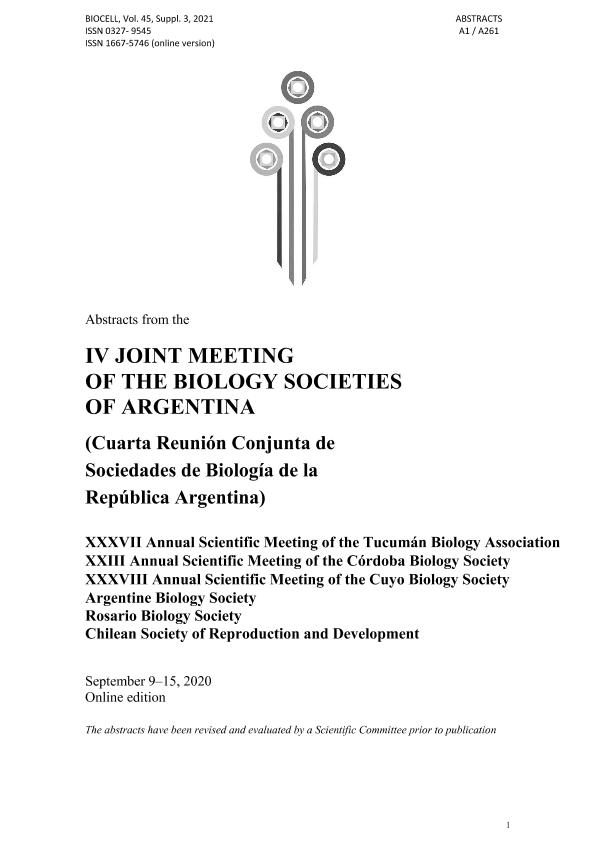Evento
Effect of a pparγ synthetic agonist associated with retinoic acid on 24-hour rhythms in the hippocampus of an experimental model of Alzheimer’s disease
Castro, A.; Mazaferro, P.; Golini, Rebeca Laura Susana ; Navigatore Fonzo, Lorena Silvina
; Navigatore Fonzo, Lorena Silvina ; Anzulovich Miranda, Ana Cecilia
; Anzulovich Miranda, Ana Cecilia
 ; Navigatore Fonzo, Lorena Silvina
; Navigatore Fonzo, Lorena Silvina ; Anzulovich Miranda, Ana Cecilia
; Anzulovich Miranda, Ana Cecilia
Tipo del evento:
Congreso
Nombre del evento:
XXXVII Annual Scientific Meeting of the Tucumán Biology Association XXIII Annual Scientific Meeting of the Córdoba Biology Society XXXVIII Annual Scientific Meeting of the Cuyo Biology Society Argentine Biology Society
Fecha del evento:
09/09/2020
Institución Organizadora:
Sociedades de Biología de la República Argentina;
Título de la revista:
Biocell
Editorial:
Tech Science Press
ISSN:
0327-9545
Idioma:
Inglés
Clasificación temática:
Resumen
Alzheimer's disease (AD) is the most frequent cause of dementia in the older adults. The main pathogenic mechanism in sporadic AD is the decreasein amyloid beta peptide (Aβ) clearance. It is known that Apolipoprotein E (Apo E) modulates Aβ deposition and clearance. ApoE expression istranscriptionally induced by PPARγ in coordination with RXRs. Previously, we found that an intracerebroventricular injection of Aβ(1-42) modifiedthe daily rhythms of Apo E, Bmal 1, and Aβ in the rat hippocampus. Taking into account those observations, the objective of this work was toinvestigate the effects of synthetic PPARγ agonist, pioglitazone, and retinoic acid (Pio-RA) on the 24-h rhythms of Apo E, BMAL1 and Aβ proteinlevels, as well as on the daily rhythms of brain-derived neurotrophic factor (Bdnf) and its receptor (TrkB) expression in the rat hippocampus. In thisstudy, male Holtzman rats from control, Aβ-injected (Aβ) and Aβ-injected treated with Pio-RA groups were euthanized throughout a 24-h period andhippocampus samples were isolated every 6 h. Apo E, BMAL1 and Aβ proteins levels were analyzed by immunoblotting and Bdnf and TrkB mRNAlevels were determined by RT-PCR. Regulatory regions of Apo E and clock genes were scanned for E-box, RORE, RXRE and PPRE sites. Weobserved that the treatment of Pio-RA reestablished the daily rhythms of Apo E, Aβ, BMAL1 protein, and Bdnf mRNA levels. This treatment alsoincreased Bdnf and TrkB levels. We found E-box, RXRE, and PPRE sites on regulatory regions of Apo E and Bmal1 genes. The results of thepresent study could suggest that the treatment of Pio-RA would not only restore the altered rhythmic patterns of the clock genes and their target genesobserved in animals injected with Aβ aggregates, but also, interestingly, would increase the levels of cognition-related genes, which are decreased inAlzheimer's patients.
Palabras clave:
ALZHEIMER DISEASE
,
PPARg
,
RETINOIC ACID
,
DAILY RHYTHM
,
HIPPOCAMPUS
Archivos asociados
Licencia
Identificadores
Colecciones
Eventos(IMIBIO-SL)
Eventos de INST. MULTIDICIPLINARIO DE INV. BIO. DE SAN LUIS
Eventos de INST. MULTIDICIPLINARIO DE INV. BIO. DE SAN LUIS
Citación
Effect of a pparγ synthetic agonist associated with retinoic acid on 24-hour rhythms in the hippocampus of an experimental model of Alzheimer’s disease; XXXVII Annual Scientific Meeting of the Tucumán Biology Association XXIII Annual Scientific Meeting of the Córdoba Biology Society XXXVIII Annual Scientific Meeting of the Cuyo Biology Society Argentine Biology Society; Argentina; 2020; 105-105
Compartir



